An emblem worthy of a mother’s love
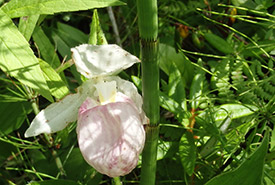
Pink lady's-slipper, ON (Photo by NCC)
Every Mother’s Day, I buy my mom her favourite chocolates and a bouquet of fresh flowers. This may seem like an easy-out gift for this day, but I’ve yet to come across a mother who doesn’t love flowers.
Mine loves yellow flowers, including variations of daisies, sunflowers, gardenias, daffodils…the list goes on. But this year, I think I might switch it up by gifting her a flower worthy of provincial honour.
Each province and territory in Canada has its own unique set of identifiers as diverse as the landscape. In addition to an official bird and mammal, each region has a designated flower representative of the area’s biodiversity.
Learn about your province’s provincial flower below.
British Columbia
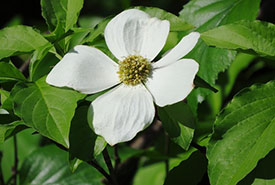
Pacific dogwood (Photo by hillanddale, CC BY-NC 4.0)
Pacific dogwood (Cornus nuttallii)
Designated in: 1956
Description: Medium-sized deciduous tree that grows up to 15 metres tall, with white flowers and small, pink fruit.
Habitat: Grows best in well-drained soils, underneath Douglas-fir, grand fir and western hemlock.
Where you can see it on NCC's BC properties: Poet Place, West Chilcotin Natural Area
National conservation status: Secure
Interesting fact: Named after Thomas Nuttall, an English botanist and zoologist.
Alberta
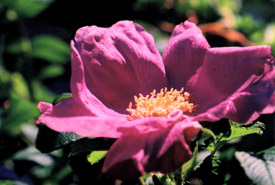
Wild rose (Photo by Mark Alexander MacDonald)
Wild rose (also known as prickly rose) (Rosa acicularis)
Designated in: 1930
Description: Deciduous shrub with pink flowers that grows up to three metres tall.
Habitat: Grows in boreal forests.
Where you can see it on NCC's Albert properties: Horseshoe Canyon
Conservation status: Secure
Interesting fact: The most common rose species growing in boreal forests in northern Canada and Alaska.
Saskatchewan
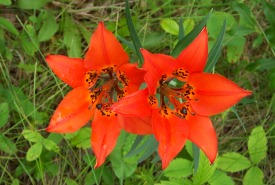
Western Red Lily at Ivey Property, SK (Photo by Desiree Idt)
Western red lily (Lilium philadelphicum)
Designated in: 1941
Description: Grows up to 89 centimetres tall and blooms six-petalled orange-red flowers between June and August.
Habitat: Grows in diverse soil types and sandy areas, such as dunes and open woods.
Where you can see it on NCC's Saskatchewan properties: Ivey Property
Conservation status: Apparently secure
Interesting fact: It has a wide distribution in Canada and can be found from British Columbia to Quebec.
Manitoba
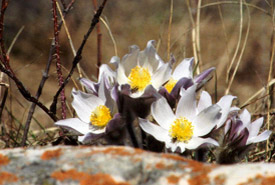
Prairie crocus in full bloom (Photo by NCC)
Prairie crocus (Anemone patens)
Designated in: 1906
Description: A short, furry perennial flower with light purple or blue flowers.
Habitat: Grows in the prairies, plains and mountain meadows.
Where you can see it on NCC's Manitoba properties: Yellow Quill Prairie Preserve, Forks Prairie Garden
Conservation status: Secure
Interesting fact: In the prairie provinces, this species is a great indicator that winter has ended and warmer weather is here to stay.
Ontario
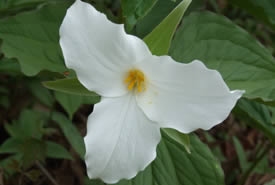
Large-flower trillium (Photo by Bernt Solymar)
White trillium (Trillium grandiflorum)
Designated in: 1937
Description: Grows low to the ground and, when in bloom, has three large, white flowers reaching up to 7.5 centimetres in length.
Habitat: Grows in well-drained, young forests and in mixed-upland forests.
Where you can see it on NCC's Ontario properties: Happy Valley Forest
Conservation status: Secure
Interesting fact: Produces berries in mid- to late summer. The berries attract ants that feed on parts of the seed. In turn, the ants help spread the plant around by carrying the seeds to their nests, where they eventually germinate.
Quebec
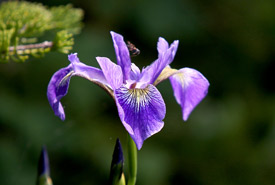
Blue flag iris (Photo by Mike Dembeck)
Blue flag iris (Iris versicolor)
Designated in: 1999
Description: Grows up to 76 centimetres tall, with several, bright blue-purple flowers when in bloom (May to early July).
Habitat: Grows in meadows, marshes and along streambanks and shores in well-drained soils.
Where you can see it on NCC's Quebec properties: Malbaie Salt Marsh
Conservation status: Secure
Interesting fact: Most widespread native iris in Canada. It is found from southern Manitoba to the Atlantic region.
New Brunswick
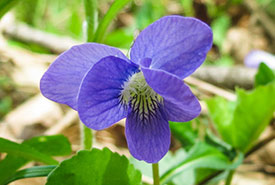
Purple violet (Photo by Jason King, CC BY-NC 4.0)
Purple violet (Viola cucullata)
Designated in: 1936
Description: Stemless and grows close to the ground (up to 20 centimetres tall) with leaves resembling bird’s feet, and with small, purple flowers.
Habitat: Prefers moist, well-drained soil rich in organic matter and can be grown in some home gardens.
Where can you see it on NCC's New Brunswick properties: Chignecto Isthmus (Lund and Dixon properties) and Bartholomew River property
Conservation status: Least concern
Interesting fact: First discovered by Scottish botanist George Don in 1831.
Nova Scotia
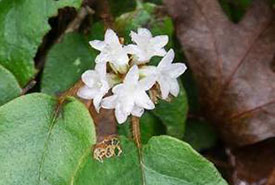
Mayflower (Photo by Rich Stevenson, CC BY-NC 4.0)
Mayflower (Epigaea repens)
Designated in: 1901
Description: Low, spreading shrub with small, pale pink flowers that are very fragrant and grow in clusters. Has woody, leafy twigs that are covered in fine, rust-coloured hair.
Habitat: Prefers moist, acidic soil and shady areas in forests.
Where you can see it on NCC's Nova Scotia properties: Brier Island
Conservation status: Secure
Interesting fact: It is used medicinally in some parts of the world to treat kidney and digestive issues.
Prince Edward Island
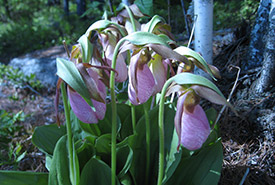
Pink lady's-slipper, Covey Hill (Photo by NCC)
Pink lady’s-slipper (Cypripedium acaule)
Designated in: 1965
Description: Grows about 25 centimetres tall, with two plicate (folded) leaves near the ground. The pink-to-magenta petals of its single flower form a pouch resembling a slipper.
Habitat: Of the three lady’s-slipper species that grow on PEI, this species is the most tolerant. It can grow in dry areas to rich, upland hardwood forests.
Where you can see it on NCC's PEI properties: Holman's Island, PEI coast and forest
Conservation status: Secure
Interesting fact: Pink lady’s-slipper is officially PEI’s provincial flower, but from 1947 to 1965 the emblem was a generic lady’s-slipper.
Newfoundland and Labrador
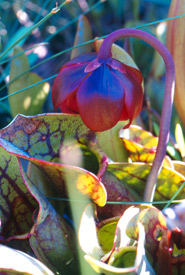
Purple pitcher plant (Photo by Helen Jones)
Purple pitcher plant (Sarracenia purpurea)
Designated in: 1954
Description: Perennial flower with purple-veined green leaves that form a rosette with a small opening at the top. Grows up to 13 centimetres tall.
Habitat: Grows primarily in sphagnum bogs and fens, but can be found in wetlands with long periods of standing water. They are native to North America and have adapted to growing in thin, nutrient-deficient soils.
Where you can see it on NCC's Newfound and Labrador properties: Grand Codroy Estuary, southwest Newfoundland
Conservation status: Secure
Interesting fact: One of Canada’s 18 carnivorous plants. It gets most of its nutrients through consuming flies, ants, spiders and moths.
Although I won’t be able to physically give my mom her Ontario trillium (since it is protected under provincial law and cannot be disturbed in any way), I know of a few forests where these flowers live. This Mother’s Day, I’m going to spend the day with my mom, in nature, looking out for this special plant and perhaps making a few memories with her with a greater shelf life than a bouquet of daisies.



